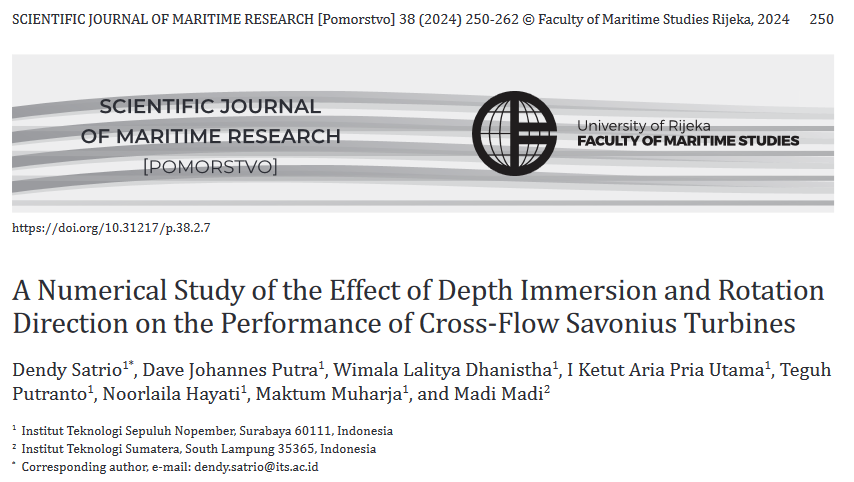Numerical Study of the Effect of Depth Immersion and Rotation Direction on the Performance Cross-Flow Savonius Turbine
Keywords:
Ocean renewable energy, Savonius turbine, Cross-flow, Depth Immersion, Rotation Direction, CFDAbstract
Energy supply is a critical variable affecting modern life. Indonesia has many renewable energies sources and one of them is ocean current. Savonius turbines, which are effective in low-speed currents, have been widely studied in their vertical form, but there has been little progress on cross-flow Savonius turbines. The turbine performance is investigated in this study by observing the behaviour caused by the influence of depth immersion, given that the surface of the submersible medium and the surface based can influence the turbulence caused. Therefore, the cross-flow Savonius turbine will be placed in three different depth conditions: 0.33H; 0.5H and 0.66H. Analysis is done with Computational Fluid Dynamics (CFD) software. The turbine's rotation direction is also set in two conditions (clockwise and counterclockwise). All these scenarios result that turbine with 0.66H and clockwise condition gives the highest results with Cp value at 0.249. The vortices flow pattern created by the clockwise configuration tends downward, in contrast to the counterclockwise which points upward. The cross-flow Savonius turbine works optimally in low TSR where its performance is greatly affected by torque.

Downloads
Published
Issue
Section
License
Copyright (c) 2024 Dendy Satrio, Dave Johannes Putra, Wimala Lalitya Dhanistha, I Ketut Aria Pria Utama, Teguh Putranto, Noorlaila Hayati, Maktum Muharja, Madi Madi

This work is licensed under a Creative Commons Attribution-NonCommercial-NoDerivatives 4.0 International License.
Scientific Journal of Maritime Research understands the need for authors to disseminate and maximize the impact of their research. When submitting an article for publishing in Scientific Journal of Maritime Research, it implies that the Corresponding Author transfers, with the consent of all Coauthors, the copyright ownership in the referenced submission, including all versions in any format now known or hereafter developed, to the Scientific Journal of Maritime Research.
Copyright protects your original work and research material and prevents others from using it without your permission. Others will be required to credit you and your work properly, thus increasing its impact. Should your submission be rejected or withdrawn prior to acceptance for publication by Scientific Journal of Maritime Research, this transfer will be null and void.
Authors, users or readers of an article need clear instructions on how they can use the article. Scientific Journal of Maritime Research uses the Creative Commons Attribution-NonCommercial-NoDerivatives (CC-BY-NC-ND) 4.0 International License, which governs the use, publishing and distribution of articles by authors, publishers and the wider general public.
The authors are allowed to post a digital file of the published article, or the link to the published article (Scientific Journal of Maritime Research web page) may be made publicly available on websites or repositories, such as the Author’s personal website, preprint servers, university networks or primary employer’s institutional websites, third party institutional or subject-based repositories, and conference websites that feature presentations by the Author(s) based on the published article, under the condition that the article is posted in its unaltered Scientific Journal of Maritime Research form, exclusively for non-commercial purposes.




